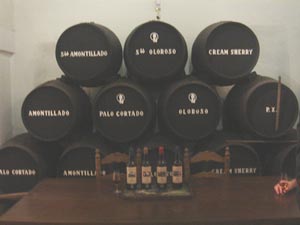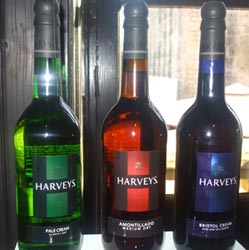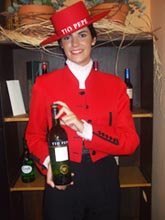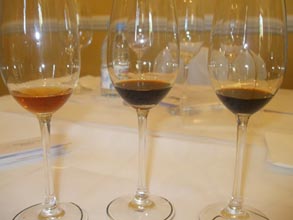
The people who drink sherry in India are dying. Surprised? Don’t be! They are dying of old age. Sherry is a legacy left behind by the British, especially for women who are getting older despite the anti-ageing fortified wine and are passing on. Sadly, the replacement market is not growing as fast as their children and grand children are attracted more towards whisky, vodka and beer. The consumption of Sherry is coming down and the future of Sherry is uncertain and dark. According to estimates, the total market for Sherry is currently less than perhaps two thousand cases (9-liters)
Having visited Vinoble, the integrated sherry and sweet wine show three times, I have seen my own palate develop where I love to ask for a second glass or third if it is a well aged Oloroso or Palo Cortado. I have become discerning enough to be able to tell the difference between the dry Fino and Manzanilla or Amontillado, or an Oloroso and Palo Cortado- and also between Pale Cream, Medium and Cream blended Sherries. Of course the Pedro Ximénez or Moscatel Sherry is the easiest to distinguish-sweet to very sweet and chewy.
I am not the only one who is confused and it took three wine shows of 3-4 days each and several guided tastings at international venues, of scores of different sherries under the guidance of experts and masters like Julian Jeff whose book ‘Sherry’ is still considered a masterpiece and is used as a standard text book for wine courses, to learn to appreciate this classic beauty from the land of flamenco dancers and beautiful horses.
The Confusing Wine
Is Sherry a wine? Not everyone will come up with the right answer in affirmative. Most would tell you correctly that it is a fortified wine produced in Spain. Using the local Palomino grapes the wine is made by ageing in the triangle area of the cities of Jerez, Sanlucar de Barrameda, and Puerto di Santa Maria in Andalucía, south of Spain.
Is Sherry dry, sweet or very sweet? Is it a single varietal or a blend? Is it age-worthy or should be drunk young? Is it vintage dated like most wines or non-vintage like most Champagnes? All of the above are applicable to Sherry-it cane be dry (called generoso) with less than 5gm/liter or extra sweet when made with Pedro Ximénez or Moscatel grape with sugar level even higher than 400 gms/liter.
There is no confusion that the alcohol level has to be minimum of 15% by law which is controlled by the Consejo Regulador established since 1933 under the Spanish government decree although there is at least one big bodega, Gonzales Byass which claims they can produce Fino with 14% alcohol, only if the laws permit. The alcohol level can be as high as 22.5% depending upon the style. Fino and Manzanilla are least alcoholic and are drunk young while some of the Oloroso and Palo Cortados and even Pedro Ximénez over 100 years old do not attract a shriek of surprise anymore- I tasted two from this category at Vinoble in May. .
The Types of Sherry
While no winemaker doubts anymore that 80-90% of the wine is made in the vineyard. this is not true for sherry where the same grape gives a wide range of styles and flavours depending also upon the aging process and which of the 3-city triangle has been used for maturing.
Sherry is made in two stages. The Palomino grapes are first fermented till an alcohol level of about 11-12% is reached. This is when the first stage of classification of Sherry takes place. The clearer wine is kept aside to be aged into dry Fino or Manzanilla or even Amontillado. When the aging is done in Sanlucar de Barrameda, the town being very close to sea gives more salty flavours and many sherry connoisseurs rate it as slightly more interesting.
The portion of wine at the bottom which still has the lees and is denser would be used to make what is called Oloroso. After removing and mixing the clear wine with distilled wine which brings the level of the fortified wine to above 15%, it is poured into old wooden casks known as butts. A gap left on the top in each butt helps form a natural layer of yeasts called flor which are present in the atmosphere and help it protect it from the oxygen in the air. This form of ageing is known as dynamic or biological ageing and after storage of a minimum three years it would give the dry Fino or Manzanilla.
On the other hand, the heavier portion is infused with distilled wine to raise the level of alcohol at 17.5% at which level the yeasts die and there is no flor that helps keep the oxygen away. This wine would be stored in the butts with a slight amount of oxygenation and would take the style of Oloroso.
Additionally there is Amontillado, which is a combination of basically the biological process and the sherry undergoing the oxidative process like Oloroso as well. Palo Cortado is the wine much in demand and is basically based on the decision of the winemaker who decides whether the sherry would age as an Oloroso or a Palo Cortado. Suffice it to know that these Sherries are all generoso (dry), single varietal, very complex wines and all very dependent on the style of the winemaker.
Blended Sherry and Harvey’s Bristol Cream
 Sherry in India has been synonymous with Harvey’s Bristol Cream. Harvey’s is a world famous sherry label bought over by the US based Jim Beam a few years ago-and is present in India as well. Available at a retail price of Rs.1800, it is sweet and complex sweet sherry classified as ‘Cream’- a blend of Oloroso and PX sherry (Pedro Ximénez) making it sweet, more than 140 gms/ liter. It makes an excellent drink with ice cubes and a couple of slices of orange. Sherry in India has been synonymous with Harvey’s Bristol Cream. Harvey’s is a world famous sherry label bought over by the US based Jim Beam a few years ago-and is present in India as well. Available at a retail price of Rs.1800, it is sweet and complex sweet sherry classified as ‘Cream’- a blend of Oloroso and PX sherry (Pedro Ximénez) making it sweet, more than 140 gms/ liter. It makes an excellent drink with ice cubes and a couple of slices of orange.
There are also two other blended Sherries called Medium and Pale Cream which are both drier than the Cream with a 15.5% minimum alcohol and a sugar level of 115-140 gm/liter. There are also Dry or Pale or Pale Dry sherries with a sugar content of a max. of 45 gms/liter. Don’t confuse Dry with Dry Sack which is the brande label from the well known bodega, Williams and Humber in Jerez; this is a Medium Dry wine with sugar content of 28 gms per liter making it a great wine on the rocks and as s dessert wine or accompaniment with spicy foods.
Ageing of Sherries
If you think the confusion ends here, wait-because sherry styles are further changed drastically with the style and type of ageing. Solera system used by keeping butts on top of each other, with each row known as Crianza-the bottom row is called Solera, is the unique system adopted to mature sherry, where the butts are kept on top of each other. Wine at the bottom is drawn off as desired for bottling and the one at the top is refilled with the newest wines of the same amount, each row being refilled by the same amount of the newer wine. Usually, there are 3-5 rows of butts, each on top of the other.
This fractional system of storage ensures that wine from different vintages is present in every sherry glass, the older vintages adding more complexity and additional layers to the flavours. Each type and style of sherry has its own Solera running at any given time.
Age Certified Sherries
It is obvious that the wine drawn finally from the Solera butt at the bottom is a combination of Sherry of several vintages, depending upon when the Solera was started, and the age of the oldest wine. Usually, it is never less than 5 years (Fino and Manzanilla must be stored for a minimum of 3 years) and many different Soleras are in operation and it is the area where the wine is being aged that is more important than where the wine was first fermented. No wonder, there are several bodegas which buy the wine and do the ageing themselves.
Since the ageing can require several years, one needs a lot of capital to block- knowing that longer the age, more complex the wine and more price it fetches. Also, if one were to define the age of Solera one refers to the average age- the youngest one being the wine with zero year age.
The law classifies VOS (very old sherry) with average Solera aging of 20 years or more and even better, VORS (very old rare sherry) with 30 years in the butt, on average. There are also Sherries with a marked indicator of 12 years and 15 years of aging..
There are certain vintages which are considered very special. These are used to make Vintage Sherries. The bodega has to apply to the Consejo Regulador which sends an inspector who on being fully satisfied seals the butt-to be opened years later and sold as the vintage sherry-the dated vintage being the year of harvest.
No Need for Confusion
Confused? You don’t need to be. So long as you know the primary difference between various Sherries, you would learn to enjoy them better. What is most important to know is that Fino and Manzanilla are very delicate aperitif wines that must be consumed young. Other wines age well-especially Oloroso and Palo Cortado and as they age, they become more complex. One also needs to remember not to look for fresh fruit or vegetal or floral aromas or flavours like in still white wines but almonds, dates, figs, cinnamon, hazelnuts, raisins are some of the common flavours and aromas in Sherry.
It is interesting to know that the rules of the Consejo Regulador specify the alcoholic strength and sugar content only, giving the winemaker and producer a liberal hand in making the type of style they like, depending upon their clientele.
Storage and Serving Sherry
It is important to know that Sherry cannot be stored in the bottle indefinitely like whisky- although it can be stored in a cool and dark corner of the house without bruising the quality . It is also important and sufficient to know that a bottle of Fino should be stored for a maximum of 12-18 months-an open bottle should be finished in a week. Amontillado and Medium can be stored for a longer period of 18-36 months and between 2-3 weeks after opening. Cream Sherry, like the Harvey’s Bristol Cream, can be left opened longer but not recommended for over 6 weeks ( I have seen opened bottles of Sherries for more than 2 months-the bartender believing it stores like whisky and storing the opened bottle indefinitely is acceptable. Unopened PX can be left longest for about 4 years with a spoilage period starting after a month or two of opening, depending on the producer.
There is also no confusion about the serving temperatures- all Sherries are always served chilled to cold –Fino being at 6-8° C, going up to 12-14 ° C for Amontillado, Oloroso or Palo Cortado. Cream has to be served a couple of degrees colder. The natural sweet Moscatels and the PX are also to be served chilled at 10-12° C.
Once you learn how to appreciate Sherry and its different styles, you will begin to enjoy it with different cuisines.
Ignorant about Sherry
 Unfortunately there is a lot of ignorance about sherry in India though we may not be in a unique position. I remember reading somewhere-some Indian writer had opined that Tio Pepe should not be in the five star hotels wine list. Such immature statements not only reflect ignorance about Sherry and its producer, but could be damaging to the brand in howsoever miniscule way-especially as the f & B personnel are also not yet informed enough about Sherry. Unfortunately there is a lot of ignorance about sherry in India though we may not be in a unique position. I remember reading somewhere-some Indian writer had opined that Tio Pepe should not be in the five star hotels wine list. Such immature statements not only reflect ignorance about Sherry and its producer, but could be damaging to the brand in howsoever miniscule way-especially as the f & B personnel are also not yet informed enough about Sherry.
Tio Pepe is a dry Fino Sherry – dry being really redundant since Fino and Manzanilla sherries are always dry (other dry styles are Amontillado, Oloroso and Palo Cortado) while Medium and Cream styles are sweet. It is the flagship brand of Gonzales Byass, a family run historic bodega in Jerez (170 family members are employed by the bodega!)
Tio Pepe is the most exported brand of Sherry. It competes with Torres as the Spanish brand with the most brand recall value. It makes the best value for money sherry. Says David Furer, a wine journalist from California who is a certified Sherry wine educator and promoted sherry in UK for four years, ‘Tio Pepe is one of the most consistent and well-made Sherries and despite big volumes, maintains quality.’ Peter Koff MW, an importer in the US feels, ‘it reflects the style of a sherry to the maximum and represents the typicity.’
Not good enough for 5-star hotels in India, did some one say? It is on the wine list of over 50 Michelin star restaurants in Spain alone, three of them being Michelin 3-star Restaurants including the celebrity Chef Ferran Adriá’s El Bully, which is frequently voted as the best restaurant of the world. In Restaurant wine lists, Tio Pepe is what the sherry wine lists start, say the Spanish gastronomy experts.
Coincidentally, Palo Cortado 1978 from Gonzales Byass, makers of Tio Pepe, won a Gold medal (only three were awarded) at the Vinoble International Competition where Subhash Arora was invited to be the President of one of the three juries.
Concluding Remarks
 |
| Shades of Sherry |
Sherry has a steady market in countries like the UK and Spain. In many other countries, demand has been stagnant or gradually going down and the Sherry producers are making concerted efforts to popularize the drink with a history of millenniums backing it. Curiously, many importers from the US and some European countries have a great love and knowledge of the wine-but they have not been able to convert it into sales, they openly concede. This could be due to the unwarranted confusion in the minds of the drinkers. Producers and the Consejo Regulador are now trying to improve the demand through education.
Education and tasting are even more important for sherry than the still wines but once the basic characteristics are comprehended through education, one can say with certainty that the market in India would increase, though not by explosive amount.
Quite Quotable Quotes
Sherry has made statesmen, scientists, artistes and writers sing songs of its praise for centuries. Following quotes are also indicative that the last few decades have not seen any new quotable quotes. (source: Big Book of Sherry Wines)
WILLIAM SHAKESPEARE: If I had a thousand sons, the first human principle I would teach them should be, to forswear thin potations and to addict themselves to sack.
PABLO NERUDA: Sherry casks, cathedrals in whose Gongoresque hearts topaz burns with a pale fire.
VICTOR HUGO: Long live the wines of Jerez! Jerez is a city that should be in Paradise.
SOMERSET MAUGHAM: Sherry is a civilised drink!
ALEXANDER FLEMING: If penicillin can cure those that are ill, sherry can bring back the dead back to life.
ALEXANDER DUMAS: Sherry, symbol of Spain’s spirit and joie de vivre.
BENITO PÉREZ GALDÓS: (Spanish realist novelist) If God had not made sherry, how imperfect his work would have been!
FRANKLIN D ROOSEVELT: ‘Here’s to the President of the United States.’ Proposing a toast in sherry from a bottle stored for 20 years awaiting his election as the President, after he won the elections in November, 1932.
LORD BYRON: ‘Twas there, in Jerez, that I drank the famous wine at the very source.
There have been several articles written on Sherry. Simply press Sherry in the Search button.
Subhash Arora: It was there in Jerez, that I drank the famous wine at the very source-
on three occasions, at Vinoble ’06, ’08, ’10.
There have been several articles written on Sherry in delWine. Simply press Sherry in the Search button at www.indianwineacademy.com
Also read The Sherry Revival at http://www.indianwineacademy.com/item_3_313.aspx |